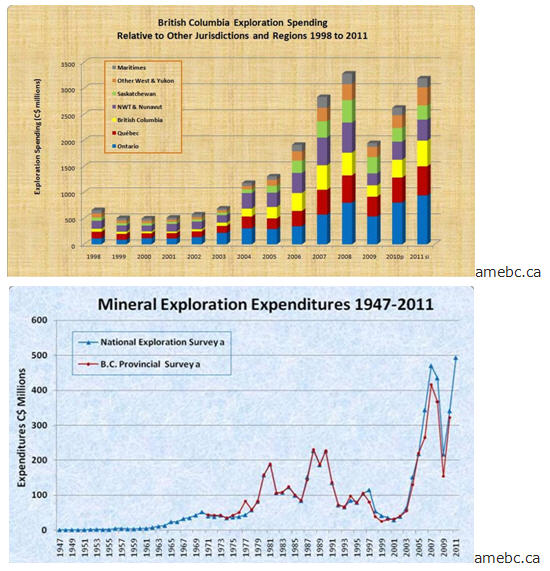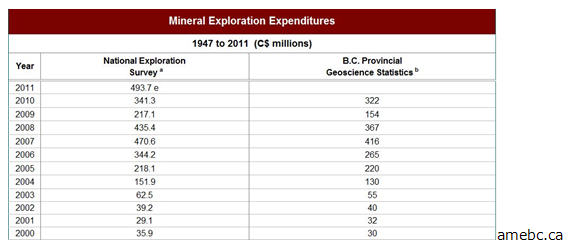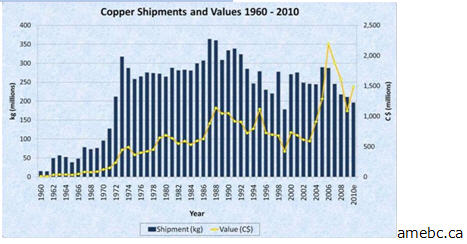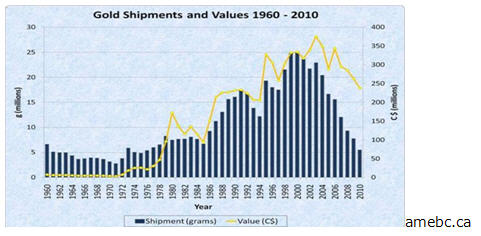Majors are rediscovering British Columbia
Vancouver BC is undoubtedly one of the greatest mining centers in the world and British Columbia should be a mining powerhouse, consider:
• Excellent geology – British Columbia is mineral rich and hugely underexplored
• Good transportation system
• Reasonable mining regulations
• Competitive tax rates
• Strategic location with respect to Asian markets. Two modern ports, Vancouver – Canada’s largest and the Port of Prince Rupert which is the closest of any of North America’s West Coast ports to Asia – up to 58 hours of sailing time shorter
• High quality and easily accessible geological data
• Mining friendly provincial government
• Communities receptive to resource extraction as a livelihood
• Attractive exploration incentives
• BC is the third largest generator of hydro electricity in Canada – one of the lowest power costs in North America. Natural gas is plentiful, cheap and resources are growing
• Some of the most modern education and telecommunications infrastructure in the world
Land claims of the First Nations remain a stumbling block in many areas – perhaps in part because so many claims overlap – but First Nations are now coming to understand and embrace resource development as a way to generate training, jobs and financial security for their people and their communities.
While things aren’t always as smooth as we would like dialogue is taking place and things are getting done – projects are moving forward.
“BC-based mineral explorers and developers appreciate the key measures that were announced in today’s federal budget. Maintaining the Mineral Exploration Tax Credit and reducing red tape will help sustain Canada’s mineral exploration and mining sector, encourage capital investment and ultimately benefit all Canadians well into the future.” Gavin C. Dirom, President and CEO of AME BC, June 6th 2011
BC is taking the lead in regulatory reform – the largest cut in red tape could come from dropping the duplication of process in regards to environmental assessments. B.C. has taken the position that the province’s own process already takes into account the responsibilities of the federal government and that doing a second duplicate federal review forces a company to spend more money and time on needless duplication of process.
The process does work – three major mines are being constructed, six major mines are in advanced development, and over eighteen mining projects are in earlier stages of environmental assessment
Mining Facts:
• The BC mining industry contributed over $7 billion annually to BC’s GDP
• Mining in BC is responsible for 14,000 direct mining jobs, an additional 35,000 indirect jobs in supporting activities, with total inferred employment in excess of 85,000
• There are currently 20 major mines, over 30 industrial mineral producers and 2 smelters operating in BC
• Companies spent $322 million on 380 exploration projects in BC in 2010, up 109% from $154 million in 2009 – this number is grossly understated as not included are many junior companies and individuals activities as well as the exploration activities of many companies domiciled outside the province
• A total of $1 billion was spent on mine development in 2010
• BC developed a mineral exploration code adapted for use in 35 countries around the world
• Sixty per cent of Canadian exploration companies are based in BC, and 69 per cent of TSX and TSX-V stock exchange listed companies based in BC are involved in the mineral exploration and mining sector
Government Support for mining
• Federal and Provincial Government support for BC’s mining sector comes in the form of:
• Extending the 15-per-cent Mineral Exploration Tax Credit to March 31st 2012
• Renewed funding for the Targeted Geoscience Initiative
• Continued reduction in corporate income tax rates
• Continued investment in modernizing the regulatory review process for major projects
• Continued investment in the Aboriginal Skills and Employment Partnership Initiative and the BC Aboriginal Mine Training Association (BCAMTA). Two major revenue sharing arrangements with First Nations are now in place – these are the first in Canada – and provide a future roadmap for how the mining industry and First Nations can work together
• Harmonized the provincial sales tax with the federal goods and services tax – HST
• Construction of the Northwest Power Line along Highway 37. This will make possible some very significant projects as well as providing power to other industrial and residential users
• Continued funding from the federal government for the Red Tape Reduction Commission
• Ottawa created regulations exempting most economic stimulus projects from the need for an environmental assessment
• Extending the BC Mining Flow-Through Share Tax Credit for another three years to 2013
• Provincial Government created Straightforward BC to track and monitor its regulations
• The Ministry of Transportation and Infrastructure is building the $200 million five year first phase of the Cariboo Connector. The project widens Hwy 97 from Cache Creek to Prince George. This will improve the Province’s interior road link to the Port of Vancouver
In 2001, the Province introduced the Mining Flow-Through Share Tax Credit to provide a 20 per cent tax credit for grass roots mineral exploration. Flow-through shares allow exploration companies to pass eligible Canadian exploration expenses to investors. When combined with a similar federal tax credit, the flow-through tax credit helps to reduce the cost of a $1,000 investment to approximately $380.
The Province has also eliminated the capital tax and the introduction of the HST will increase the savings from the current sales tax exemption for mining machinery and equipment by eliminating all sales tax currently paid on mining inputs when fully implemented.
The “new mine allowance” encourages the development of new mines by allowing for a deduction of 133% of capital costs incurred to bring a new mine into production. This program runs till January 1st 2016.
BC Mining Tax Credits
In BC a mineral exploration company can raise equity funding in one of two ways, each of which is tax advantaged. These types of share issues are normally referred to as hard dollars or soft dollars.
Hard dollars come from non-flow-through stock that is issued, usually at market price or at a slight discount. Hard dollars can be spent on all capital expenditures including exploration, office expenses or promotion. If the hard dollars are spent on exploration, a company will get 20% of that amount back from the provincial government through the Mining Exploration Tax Credit (METC), and if the exploration is in a pine beetle kill area that credit jumps to 30%.
Most of BC is now classified as in the pine beetle kill area, so the majority of companies now get 30% of qualifying exploration expenditures back. This tax credit is usually paid three to six months after the claim is filed. The remaining after tax credit amount of 80% or 70% is added to the company’s Canadian Exploration Expense (CEE) pool to be used for future tax sheltering which has an advantage of never expiring and is 100% deductible against any capital gains in the future.
Soft dollars come from issuing flow-through shares to investors. The continuation of the BC Mining Flow-Through Shares Tax Credit (BCFTSTC) and the Federal Investment Tax Credit is intended to help companies raise capital for mining exploration by providing an incentive to individuals who invest in flow-through shares issued to finance exploration. The program only applies to preliminary mineral exploration activities conducted from surface. Expenses for underground exploration or for the purpose of bringing a mine into production are excluded.
A company can issue flow-through shares at a premium to the market price, preserving their capital structure with less dilution, since buyers will end up getting tax savings and credit from the purchase. The company can only spend this money on exploration in Canada, nowhere else, and it must be spent within a limited period of time. For the privilege of issuing stock at above market prices, all the exploration expenses flow through to investors and the company does not get any tax credit money or CEE tax pools.
Geoscience BC
The Province of British Columbia is very progressive when it comes to mineral exploration. In 2005, the province implemented online staking – saves exploration companies money and time by allowing ground to be staked on the internet instead of boots on the ground.
The province also created – in 2005 with a $25 mm grant – an organization to put money into grassroots exploration in BC. Geoscience BC is an industry-focused organization with a mandate to encourage mineral, oil and gas exploration investment in British Columbia through the collection, interpretation and marketing of publically available, applied geoscience.
Subsequently, almost $12 million has been given to Geoscience BC to spend on grassroots mineral and oil & gas projects.
Geoscience BC puts money in the ground by funding regional airborne surveys and soil sampling projects. As an example Geoscience BC’s QUEST Project in south central BC, covered the Cariboo Region and included an airborne electromagnetic (EM) survey, an airborne gravity survey and the collection of 2,200 new geochemical samples. Projects such as this help exploration companies identify targets and do grassroots exploration that would have been too expensive and high risk to undertake previously.
Gold, Copper and Gold
“What really bothers me is that in the 1980s or 1990s, we saw three to five discoveries of 5 to 20 million ounces each, and upwards of 30 to 50 million ounces a year. That is what makes or breaks the industry. There are no discoveries of that magnitude now.” Pierre Lassonde a veteran gold analyst, co-founder/chairman of Franco Nevada Mining Corp., acting chairman of the World Gold Council, and former president of Newmont Mining Corp. For The Gold Report www.aureport.com
Each year the mining industry must come up with a major new gold discovery of five million ounces just to replace what one of the world’s top gold miner’s digs up.
“In the case of gold, the world is currently mining it faster than it is finding it. Furthermore the average size and grade of gold discoveries continues to decline.” Richard Schodde, Managing Director of MinEx Consulting
Mining is the story of depleting assets, that asset must be constantly replenished; miners that want to stay in business must replace every oz taken out of the ground and there isn’t a lot of the larger size gold deposits left to find or buy that would really affect most of these larger company’s bottom lines. Replacing what they’ve mined let alone finding more productivity/resources is getting harder and harder.
In BC, there are two styles of mineralization that are becoming increasingly important in the global quest to replace declining gold production. These two styles are porphyry copper/gold mineralization and sediment hosted mineralization.
Porphyry Copper/Gold Deposits
Porphyry copper deposits are copper orebodies which are associated with porphyritic intrusive rocks and the fluids that accompany them. Porphyry orebodies typically contain between 0.4 and 1 % copper with smaller amounts of other metals such as gold, molybdenum and silver.
In Canada, British Columbia enjoys the lion’s share of this type of deposit, and they contain the largest resources of copper, significant molybdenum and 50% of the gold in the province.
There’s a very real trend by the major mining companies towards making deals with the junior resource companies that presently own copper/gold porphyry projects in BC:
• Tiex/Newmont
• Novagold/Teck Resources
• Cariboo Rose/Gold Fields
• Terrane Metals/Goldcorp
• Kiska Metals (formerly Rimfire Metals)/Xstrata
• Serengeti/Freeport
• Strongbow/Xstrata
• Copper Mountain/Mitsubishi
Because large pure gold deposits are so hard to find – the low hanging fruit has already been picked – gold miners are turning to deposits that contain other metals like copper.
There are two factors that make these kinds of deposits so attractive – firstly by focusing on profitability and mine life instead of solely on grade your other inputs of scale/cost can offset the lower grade and this results in almost identical gross margins between high and low grade deposits. Low grade can mean big profits for mining companies.
The second factor affecting profitability of these often immense deposits is the presence of more than one payable metal. For gold miners using co-product (copper) accounting the cost of gold production is usually way below the industry average.
Copper-gold porphyries can offer both size and profitability. These kinds of deposits are one of the few deposit types containing gold that have both the scale and the potential for decent economics that a major mining company can feel comfortable going after to replace and add to their gold reserves.
Sediment Hosted Vein (SHV) deposit’s
The term Sediment Hosted Vein (SHV) deposit is used for a family of gold deposits that consist of gold in quartz and quartz-carbonate veins hosted by shale and siltstone sedimentary rocks. These deposits occur throughout the world, but are most prolific in size and number in Asia. Most are poorly known to westerners because of their location in the former Soviet Union.
SHV gold deposits are some of the largest in the world:
• Muruntau >80M oz. “Hilly place” opened in the Kyzyl-Kum desert of Uzbekistan in 1969.The mine is still worked as an open pit now nearly 4km (2.5 miles) long, over 2.5km (1.55 miles) wide, and nearly 400 metres (1,300 feet) deep. The Muruntau Mine produces enough gold to make the Republic of Uzbekistan the world’s ninth largest gold producing country – the mine produces around 70% of Uzbekistan’s total gold output
• Sukhoy Log >20M oz. Detailed exploration of the Sukhoi Log deposit started in the autumn of 1971. The work included 209.6 km of diamond core drilling in 846 drill holes, 11.7 km of underground drives, 61 raises, 110.3 km of trenches, 13,000 channel samples, three bulk samples of 150 t, 800 t, and 980 t and tens of thousands of assays for gold, In addition to the Sukhoi Log deposit, several lesser gold deposits of the same type were discovered in the region
• Amantaytau, Daugiztau, Kumtor, Bakirchik, Olympiada, Nezhdaninskoe, Natalka, and Maysky are all over 5M oz
All SHV deposits have characteristics in common with each other:
• Tectonic setting
• Host rocks
• Alteration style
• Metal content
• Hydrothermal fluid chemistry
• Absolute and relative timing of formation
Attractive characteristic of SHV deposits are:
• They can be gold-only systems and therefore are metallurgically simple
• SHV deposits are associated with prolific placer gold fields if conditions are right for the formation of placer deposits
• Sulfide content is low for this type of deposit
• Type of setting is specific and identifiable among sedimentary belts of the world
• SHV deposits occur in groups, usually with one large deposit associated with numerous satellite deposits
Conclusion
One of the most serious and unpredictable risks facing mining operations and investor interests is “country risk” – where the political and economic stability of the host country is questionable and abrupt changes in the business environment could adversely affect profits or the value of the company’s assets.
Large capital investments made by mining companies are immobile – if the management side of the companies we invest in is so important then maybe we should start regarding the management of the country they operate in as at least as important?
The Province of British Columbia, Canada is experiencing a mining renaissance. What’s happening in the Province, in regards to mining, should be on every investors radar screen. Is it on yours?
If not, maybe it should be.
Richard (Rick) Mills
rick@aheadoftheherd.com
www.aheadoftheherd.com
***
Legal Notice / Disclaimer
This document is not and should not be construed as an offer to sell or the solicitation of an offer to purchase or subscribe for any investment. Richard Mills has based this document on information obtained from sources he believes to be reliable but which has not been independently verified; Richard Mills makes no guarantee, representation or warranty and accepts no responsibility or liability as to its accuracy or completeness. Expressions of opinion are those of Richard Mills only and are subject to change without notice. Richard Mills assumes no warranty, liability or guarantee for the current relevance, correctness or completeness of any information provided within this Report and will not be held liable for the consequence of reliance upon any opinion or statement contained herein or any omission. Furthermore, I, Richard Mills, assume no liability for any direct or indirect loss or damage or, in particular, for lost profit, which you may incur as a result of the use and existence of the information provided within this Report.
Richard Mills owns shares of Tiex Inc. TSX.V – TIX
TIX and Cariboo Rose TSX.V – CRB are sponsors of his site aheadoftheherd.com.
{{ commodity.name }}
{{ post.title }}
{{ post.date }}






Comments
bocacassidy
Rejection by Ottawa In the BC provincial government approval of Taseko’s PROSPERITY project serves as a warning to the financial community that there is in fact political risk !
The real power in Canada is just as centralized as in the former USSR,
Provincial autonomy is a facade